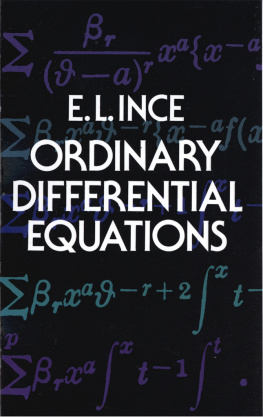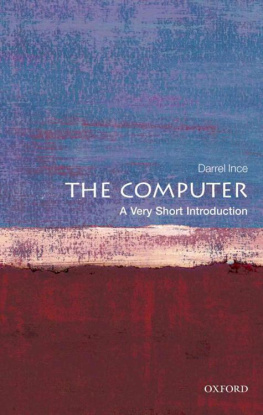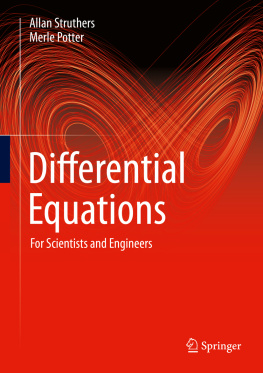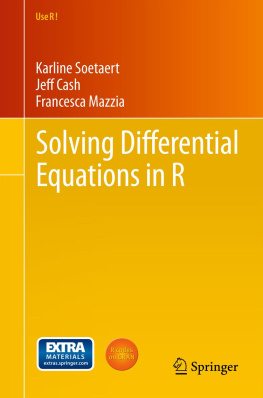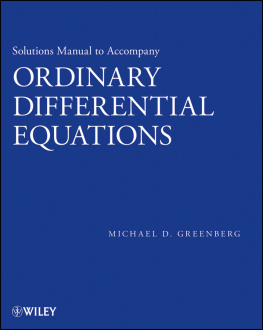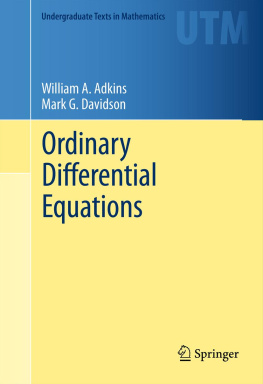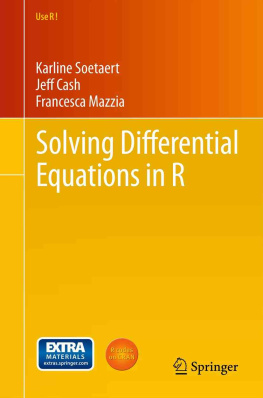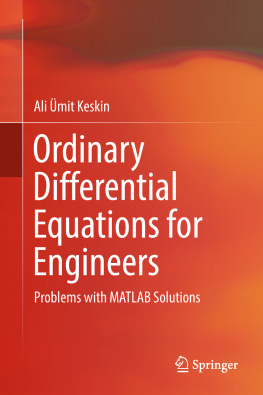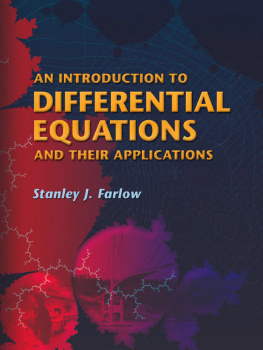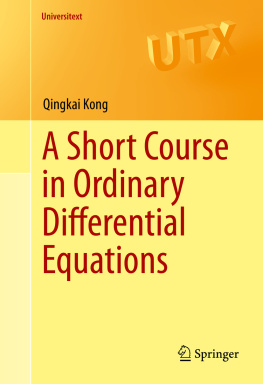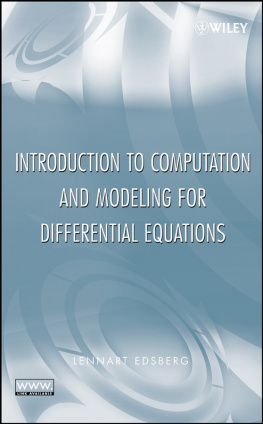Ince - Ordinary Differential Equations
Here you can read online Ince - Ordinary Differential Equations full text of the book (entire story) in english for free. Download pdf and epub, get meaning, cover and reviews about this ebook. year: 2013, publisher: Dover Publications, genre: Children. Description of the work, (preface) as well as reviews are available. Best literature library LitArk.com created for fans of good reading and offers a wide selection of genres:
Romance novel
Science fiction
Adventure
Detective
Science
History
Home and family
Prose
Art
Politics
Computer
Non-fiction
Religion
Business
Children
Humor
Choose a favorite category and find really read worthwhile books. Enjoy immersion in the world of imagination, feel the emotions of the characters or learn something new for yourself, make an fascinating discovery.
Ordinary Differential Equations: summary, description and annotation
We offer to read an annotation, description, summary or preface (depends on what the author of the book "Ordinary Differential Equations" wrote himself). If you haven't found the necessary information about the book — write in the comments, we will try to find it.
Ince: author's other books
Who wrote Ordinary Differential Equations? Find out the surname, the name of the author of the book and a list of all author's works by series.
Ordinary Differential Equations — read online for free the complete book (whole text) full work
Below is the text of the book, divided by pages. System saving the place of the last page read, allows you to conveniently read the book "Ordinary Differential Equations" online for free, without having to search again every time where you left off. Put a bookmark, and you can go to the page where you finished reading at any time.
Font size:
Interval:
Bookmark:
ORDINARY DIFFERENTIAL EQUATIONS ORDINARY DIFFERENTIAL EQUATIONS BY E. L. INCE PROFESSOR OF PURE MATHEMATICS IN THE EGYPTIAN UNIVERSITY WITH DIAGRAMS DOVER PUBLICATIONS, INC. NEW YORK This Dover edition, first published in 1956, is an unabridged and unaltered republication of the work originally published in 1926. It is reprinted by special arrangement with Longmans, Green and Co. 11501 PREFACE I N accordance with the tradition which allows an author to make his preface serve rather as an epilogue, I submit that my aim has been to introduce the student into the field of Ordinary Differential Equations, and thereafter to guide him to this or that standpoint from which he may see the outlines of unexplored territory. 11501 PREFACE I N accordance with the tradition which allows an author to make his preface serve rather as an epilogue, I submit that my aim has been to introduce the student into the field of Ordinary Differential Equations, and thereafter to guide him to this or that standpoint from which he may see the outlines of unexplored territory.
Naturally, I have not covered the whole domain of the subject, but have chosen a path which I myself have followed and found interesting. If the reader would pause at any point where I have hurried on, or if he would branch off into other tracks, he may seek guidance in the footnotes. In the earlier stages I ask for little outside knowledge, but for later developments I do assume a growing familiarity with other branches of Analysis. For some time I have felt the need for a treatise on Differential Equations whose scope would embrace not merely that body of theory which may now be regarded as classical, but which would cover, in some aspects at least, the main developments which have taken place in the last quarter of a century. During this period, no comprehensive treatise on the subject has been published in England, and very little work in this particular field has been carried out; while, on the other hand, both on the Continent and in America investigations of deep interest and fundamental importance have been recorded. The reason for this neglect of an important branch of Analysis is that England has but one school of Pure Mathematics, which implies a high development in certain fields and a comparative neglect of others.
To spread the energies of this school over the whole domain of Pure Mathematics would be to scatter and weaken its forces; consequently its interests, which were at no time particularly devoted to the subject of Differential Equations, have now turned more definitely into other channels, and that subject is denied the cultivation which its importance deserves. The resources of those more fortunate countries, in which several schools of the first rank flourish, are adequate to deal with all branches of Mathematics. For this reason, and because of more favourable traditions, the subject of Differential Equations has not elsewhere met with the neglect which it has suffered in England. In a branch of Mathematics with a long history behind it, the prospective investigator must undergo a severer apprenticeship than in a field more recently opened. This applies in particular to the branch of Analysis which lies before us, a branch in which the average worker cannot be certain of winning an early prize. Nevertheless, the beginner who has taken the pains to acquire a sound knowledge of the broad outlines of the subject will find manifold opportunities for original work in a special branch.
For instance, I may draw attention to the need for an intensive study of the groups of functions defined by classes of linear equations which have a number of salient features in common. Were I to acknowledge the whole extent of my indebtedness to others, I should transfer to this point the bibliography which appears as an appendix. But passing over those to whom I am indebted through their published work, I feel it my duty, as it is my privilege, to mention two names in particular. To the late Professor George Chrystal I owe my introduction to the subject; to Professor E. T. Whittaker my initiation into research and many acts of kind encouragement.
And also I owe to a short period of study spent in Paris, a renewal of my interest in the subject and a clarifying of the ideas which had been dulled by war-time stagnation. In compiling this treatise, I was favoured with the constant assistance of Mr. B. M. Wilson, who read the greater part of the manuscript and criticised it with helpful candour. The task of proof-correction had hardly begun when I was appointed to my Chair in the Egyptian University at Cairo, and had at once to prepare for the uprooting from my native country and transplanting to a new land.
Unassisted I could have done no more than merely glance through the proof-sheets, but Mr. S. F. Grace kindly took the load from my shoulders and read and re-read the proofs. These two former colleagues of mine have rendered me services for which I now declare myself deeply grateful. My acknowledgments are also due to those examining authorities who have kindly allowed me to make use of their published questions; it was my intention to add largely to the examples when the proof stage was reached, but the circumstances already mentioned made this impossible.
And lastly, I venture to record my appreciation of the consideration which the publishers, Messrs. Longmans, Green and Co., never failed to show, a courtesy in harmony with the traditions of two hundred years. If this book is in no other respect worthy of remark, I can claim for it the honour of being the first to be launched into the world by a member of the Staff of the newly-founded Egyptian University. In all humility I trust that it will be a not unworthy forerunner of an increasing stream of published work bearing the name of the Institution which a small band of enthusiasts hopes soon to make a vigorous outpost of scientific enquiry. E. INCE. INCE.
H ELIOPOLIS ,
December, 1926. CONTENTS PART I
DIFFERENTIAL EQUATIONS IN THE REAL DOMAIN PART II
DIFFERENTIAL EQUATIONS IN THE COMPLEX DOMAIN PART I DIFFERENTIAL EQUATIONS IN THE REAL DOMAIN CHAPTER I INTRODUCTORY 11. Definitions. The term quatio differentialis or differential equation was first used by Leibniz in 1676 to denote a relationship between the differentials dx and dy of two variables x and y. Such a relationship, in general, explicitly involves the variables x and y together with other symbols a, b, c, which represent constants. This restricted use of the term was soon abandoned; differential equations are now understood to include any algebraical or transcendental equalities which involve either differentials or differential coefficients.
It is to be understood, however, that the differential equation is not an identity. Differential equations are classified, in the first place, according to the number of variables which they involve. An ordinary differential equation expresses a relation between an independent variable, a dependent variable and one or more differential coefficients of the dependent with respect to the independent variable. A partial differential equation involves one dependent and two or more independent variables, together with partial differential coefficients of the dependent with respect to the independent variables. A total differential equation contains two or more dependent variables together with their differentials or differential coefficients with respect to a single independent variable which may, or may not, enter explicitly into the equation. The order of a differential equation is the order of the highest differential coefficient which is involved.
When an equation is polynomial in all the differential coefficients involved, the power to which the highest differential coefficient is raised is known as the
Next pageFont size:
Interval:
Bookmark:
Similar books «Ordinary Differential Equations»
Look at similar books to Ordinary Differential Equations. We have selected literature similar in name and meaning in the hope of providing readers with more options to find new, interesting, not yet read works.
Discussion, reviews of the book Ordinary Differential Equations and just readers' own opinions. Leave your comments, write what you think about the work, its meaning or the main characters. Specify what exactly you liked and what you didn't like, and why you think so.

